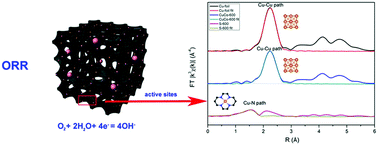Incorporation of Cu–Nx cofactors into graphene encapsulated Co as biomimetic electrocatalysts for efficient oxygen reduction†
Abstract
Unlike metals with incomplete d-shells such as Pt and Fe, copper (Cu) with a filled d-electron shell is generally regarded as a sluggish oxygen reduction reaction (ORR) electrocatalyst. However, laccase and other copper enzymes could catalyze the ORR efficiently in nature. Inspired by this, we incorporated Cu–Nx cofactors (Cu–N2 and Cu–N4) into graphene encapsulated Co frameworks by direct annealing of MOFs with a post etching process. The bioinspired electrocatalyst exhibits excellent performance and stability for ORR which is comparable to or even better than Pt/C. Meanwhile, it also illustrates a fantabulous performance in a zinc–air battery device. The excellent performance can be ascribed to the abundant atomically dispersed Cu–Nx cofactors in the graphene frameworks confirmed by aberration corrected HAADF-STEM and XAFS analyses. Density functional theory calculations suggest that when Cu atoms are coordinated with the surrounding N atoms, the valence electrons of Cu atoms will transfer to nitrogen atoms, simultaneously tuning the d electronic states near the Fermi level to realize fast ORR kinetics.

- This article is part of the themed collection: 2018 Nanoscale HOT Article Collection


 Please wait while we load your content...
Please wait while we load your content...